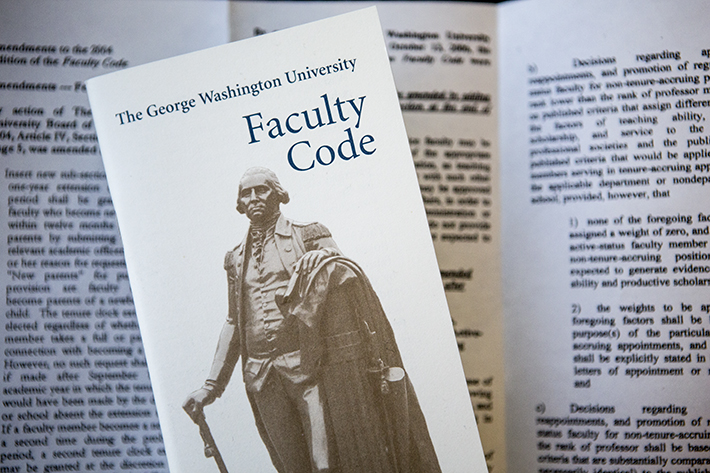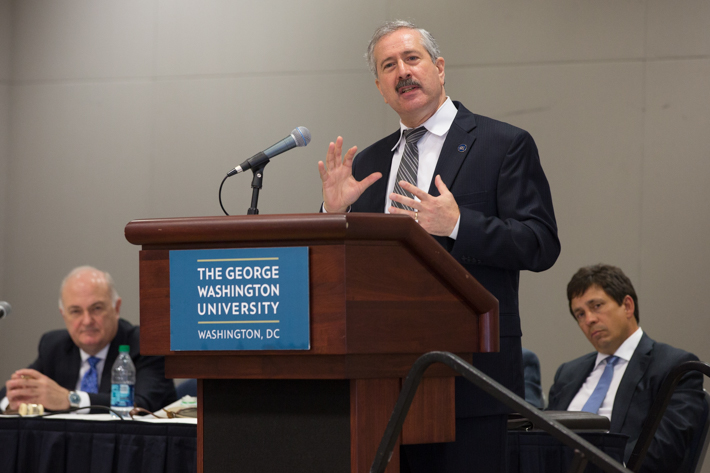Concerns about a change to the university’s tuition remission benefit were addressed at Friday’s Faculty Senate meeting.
Professor Joseph Cordes, acting chair of the Faculty Senate’s Fiscal Planning and Budgeting Committee, discussed the implementation of the new policy for tuition remission and why employees hired under the former policy are not being grandfathered in.
In September, the university announced it would revise tuition remission to provide full-time and part-time faculty and staff up to 18 credits per year at 90 percent tuition remission (compared with 96 percent previously). The change goes into effect Jan. 1, 2015.
Implementation without grandfathering current employees was needed to provide immediate savings in employee contributions to health insurance, Dr. Cordes said. The tuition remission adjustment will save the university nearly $750,000, which will go toward reducing health insurance premiums.
After Dr. Cordes’ presentation, Faculty Senate members introduced a resolution to grandfather employees hired on or before Nov. 14, 2014, into the university’s existing tuition remission benefit. The resolution will be referred to the Executive Committee of the Faculty Senate, which will decide to either refer it to committee or bring it to the floor.
In response to questions from Faculty Senate members, Provost Steven Lerman said GW’s new tuition remission benefit is comparable to what other universities offer. When considering changes, the university looked at 20 peer institutions and found GW’s benefit was greater than those of its peers.
Annually, the university contributes more than $14.5 million a year toward tuition remission, Dr. Lerman said.
In a Nov. 10 letter to the university community, Dr. Lerman and Vice President Sabrina Ellis wrote, “Even with this change, we are confident that our tuition remission benefit continues to be competitive when compared with peer institutions and the use of the savings from this change to reduce the increases in health insurance premiums paid by everyone at GW was the right tradeoff.”
As a follow up to a presentation made by Board of Trustees Chair Nelson Carbonell, B.S. ’85, at last month’s Faculty Assembly, Trustee and Chair of the Academic Affairs Committee Madeleine Jacobs, B.S. ’68, discussed the progress of several working groups appointed to review faculty governance.
The four groups—participation; appointment, promotion and tenure; appointment and review of academic administrators; and school rules and procedures—have each met at least five times since September, Ms. Jacobs said.
“They have a charge to look at different things within each of these topics,” she said. “We want to be sure that any recommendations that come to the Faculty Senate or the Board of Trustees are going to be recommendations that are well thought out and fully explored, that that we’ve thought about all the implications.”
Dr. Lerman ended the meeting with an update on the Science and Engineering Hall (SEH) and how the university will pay for the $275 million building.
Funding for the SEH comes from three sources: revenue from Square 54 where The Avenue is located, philanthropy and indirect cost recoveries from research.
Dr. Lerman said revenue from Square 54 has been more than anticipated, and the majority of the capital cost—$225 million to $250 million—will be paid with it. Historic lows for long-term fixed rate debt have also enabled the university to finance more of the cost of the building for the same dollars, he said.
To date, the university has raised $7 million in philanthropic donations toward the capital construction as well as $35.8 million for programmatic activities tied to the building and $7 million in equipment donations.
The Milken Institute School of Public Health and the School of Medicine and Health Sciences, which will be housed on the seventh and eighth floors of the SEH, will contribute $17 million to the building’s capital construction costs. Future indirect cost recoveries for research, estimated to be about $25 million, will be put toward the project as well.
“The big picture is that the capital project will not be paid for by tuition dollars,” Dr. Lerman said. The building is scheduled to open in January.





